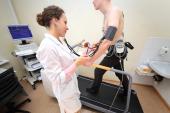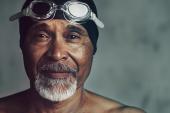Cardiorespiratory Fitness Is Key to Longevity, Regardless of Age, Sex, and Race
Instead of asking patients how much they exercise, Claudio Gil Araújo suggests focusing on their fitness level.

Above all other risk factors, cardiorespiratory fitness may play the starring role in predicting longevity regardless of age, sex, and race, according to new Veterans Affairs (VA) data. Moreover, extremely high exercise capacity did not have any adverse impact on mortality.
“These findings have public health significance, particularly for septuagenarians and octogenarians, considering the limited information on the association between cardiorespiratory fitness and mortality risk in this growing segment of the population,” write Peter Kokkinos, PhD (Washington DC VA Medical Center), and colleagues. “Thus, it is prudent that cardiorespiratory fitness status be included in routine clinical practice, as advocated by public health professionals and recent scientific statements.
Commenting on the retrospective study for TCTMD, Claudio Gil Araújo, MD, PhD (Exercise Medicine Clinic – CLINIMEX; Rio de Janeiro, Brazil), said it confirms “what most cardiologists don't think about: that fitness is much more important than everything else.”
This is key, he continued, because while most physicians ask patients how much exercise they do, a better question is: “How fit are you?” Moreover, Araújo said, for physicians “the priority is not fitness [or] health, it's disease. The general population wants to know about health. They don't want to know about disease. Many physicians don't know anything about exercise. They say people can just walk.”
Fit People Live Longer
For the study, published in the August 9, 2022, issue of the Journal of the American College of Cardiology, Kokkinos and colleagues included more than 750,000 US veterans aged 30 to 95 years. The mean age was 61.3 years, with 14.7% being septuagenarians and 3.6% being octogenarians. Also, 19.0% were African Americans, 4.7% were Hispanics, 2.1% were Native Americans, and 6.0% were women. Stratified by mean peak MET levels on a standard treadmill test, patients fell into six groups:
- Least fit (4.7 METs): 17.8%
- Low fit (7.1 METs): 27.7%
- Moderately fit (9.0 METs): 20.9%
- Fit (10.4 METs): 17.4%
- Highly fit (12.1 METs): 12.0%
- Extremely fit (14.3 METs): 4.2%
Over a median 10.2 years of follow-up, 23.3% of the population died. Higher exercise capacity was inversely associated with mortality risk for the entire cohort across the spectrum of age, sex, and race/ethnicity (adjusted HR 0.86 per 1-MET increase; 95% CI 0.85-0.87). Compared with the extremely fit, adjusted cardiovascular mortality risk was highest for individuals considered least fit (adjusted HR 4.09; 95% CI 3.94-4.24) and low fit (HR 2.88; 95% CI 2.78-2.99).
Traditional risk factors like chronic kidney disease, smoking, diabetes, atrial fibrillation, cancer, cardiovascular disease, hypertension, and age all were independently linked to increased mortality risk, as well, but none as strongly as cardiorespiratory fitness. Interestingly, higher body mass index (BMI) predicted better survival (adjusted HR 0.98; 95% CI 0.97-0.98).
‘Preliminary’ in Women
While Araújo stressed the importance of these findings, he said they can only be considered “preliminary” in women, given their low numbers in the study cohort. Also, he pointed out, the female patients “who go to the VA are women that came from military service, and so they are not going to be representative of the general [female] population. . . . They tend to be fitter.”
Additionally, he stressed that treadmill tests are not a perfect way to measure cardiorespiratory fitness, though they are more objective than, for example, a questionnaire. “That is a major limitation of this study, because they estimated physical fitness based on treadmill time,” Araújo said, citing other studies that measure oxygen intake using masks.
But the study does provide reassurance that “there is no harm in being very, very highly fit,” he continued. This is relevant to some athletes who get older and might consider stopping their marathons or other intensive exercise out of fear of added risk. In general, though, Araújo said the main message is that “depending on your genetics, depending on your background, depending on what you have done since you were a kid and adolescent, the target should be to be fit.”
As for how diet might interact with fitness levels to influence longevity or early mortality, the study didn’t look at this specifically, but Araújo pointed to the paradoxical relationship observed with BMI and mortality. Also, the median BMI in the extremely fit group was “overweight” at 27.7 kg/m2, which may speak to the fact that BMI is not a perfect measurement of health or even body fat, he noted. Still, given the “high” rates of dyslipidemia and diabetes also seen in the extremely fit cohort, Araújo said diet is unlikely to play a role in improving longevity at a level anywhere close to that of fitness.
In the future, Araújo would like to see research explore the combined effects of both cardiorespiratory and musculoskeletal fitness on survival.
‘Fit Is It’
In an accompanying editorial, Carl J. Lavie, MD (Ochsner Clinical School–The University of Queensland School of Medicine, New Orleans, LA), and colleagues agree that “US and European guidelines should include cardiorespiratory fitness as a CVD predictor and health marker at all ages, independently of both sex and race.” And while clinicians should maintain their focus on lowering lipids, blood sugar, blood pressure, and weight, they should be putting an equal amount of effort into reminding patients to improve their cardiorespiratory fitness.
Conducting clinical graded exercise testing in the manner done in this study could potentially be used more frequently in patient evaluations, the editorialists suggest. “Objectively quantifying one’s cardiorespiratory fitness may eliminate any false impressions of a patient’s self-reported physical activity level, which is often misrepresented by recall error,” they write.
“Identifying those in the least-fit categories for their age and sex can help prompt referrals to clinical exercise physiologists and/or other exercise programs aimed at supporting the adoption of a physically active lifestyle at levels that have been demonstrated to improve cardiorespiratory fitness, as the evidence supports that fit is it for healthy living and longevity across populations,” the editorial concludes.
Yael L. Maxwell is Senior Medical Journalist for TCTMD and Section Editor of TCTMD's Fellows Forum. She served as the inaugural…
Read Full BioSources
Kokkinos P, Faselis C, Samuel IBH, et al. Cardiorespiratory fitness and mortality risk across the spectra of age, race, and sex. J Am Coll Cardiol. 2022;80:598-609.
Lavie CJ, Sanchis-Gomar F, Ozemek C. Fit is it for longevity across populations. J Am Coll Cardiol. 2022;80:610-612.
Disclosures
- Kokkinos and Araújo report no relevant conflicts of interest.
- Lavie previously served as a speaker and consultant for PAI Health on their PAI (Personalized Activity Intelligence) applications.





Comments